Development and Validation of Staging Systems for AA Amyloidosis
- PMID: 38512269
- PMCID: PMC11164117
- DOI: 10.1681/ASN.0000000000000339
Development and Validation of Staging Systems for AA Amyloidosis
Abstract
Key Points:
Patients with AA amyloidosis and age ≥65 years, eGFR <45 ml/min per 1.73 m2, and N-terminal type-B natriuretic peptide >1000 ng/L and/or type-B natriuretic peptide >130 ng/L at diagnosis have poorer survival.
Proteinuria >3.0 g/24 hours and eGFR <35 ml/min per 1.73 m2 identify patients at high risk of progression to end-stage kidney failure.
Prognostic stratification in AA amyloidosis can be easily made by staging systems, similarly to AL and transthyretin amyloidosis.
Background: The kidney is involved in almost 100% of cases of AA amyloidosis, a rare disease caused by persistent inflammation with long overall survival but frequent progression to kidney failure. Identification of patients with advanced disease at diagnosis is difficult, given the absence of validated staging systems.
Methods: Patients with newly diagnosed AA amyloidosis from the Pavia (n=233, testing cohort) and Heidelberg (n=243, validation cohort) centers were included in this study. Cutoffs of continuous variables were determined by receiver operating characteristic analysis predicting death or dialysis at 24 months. Prognostic factors included in staging systems were identified by multivariable models in the testing cohort.
Results: Age ≥65 years, eGFR <45 ml/min per 1.73 m2, and elevated natriuretic peptides (type-B natriuretic peptide >130 ng/L and/or N-terminal type-B natriuretic peptide >1000 ng/L) were associated with overall survival and included in the staging system (all with simplified coefficients 1). Mean 36-month overall survival was lower with higher staging system scores (score 0–1: 92%; score 2: 72%; score 3: 32%). These results were confirmed in the validation cohort. For kidney failure, variables selected to enter in the staging system model were proteinuria >3 g/24 hour and eGFR <35 ml/min per 1.73 m2 (both with simplified coefficients 1). The 36-month cumulative incidence of kidney failure was higher with higher staging system scores (score 0: 0%; score 1: 24%; score 2: 51%). Again, similar results were obtained in validation cohort.
Conclusions: We identified and validated biomarker-based staging systems for overall survival and kidney failure in AA amyloidosis.
Conflict of interest statement
Disclosure forms, as provided by each author, are available with the online version of the article at
Figures

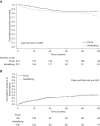
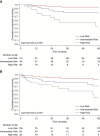
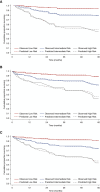
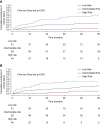
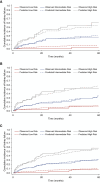
References
Publication types
MeSH terms
Substances
Grants and funding
- GR-2018-12368387/Ministero della Salute
- PRIN 20207XLJB2/Ministero dell’Istruzione, dell’Università e della Ricerca
- grant #2018-0257/Fondazione Cariplo
- Accelerator Award Program/Cancer Research UK 403 [C355/A26819], FC AECC and AIRC
- PRIN 20207XLJB2/Ministero dell'Istruzione, dell'Università e della Ricerca
LinkOut - more resources
Full Text Sources
Medical
Research Materials
Miscellaneous

